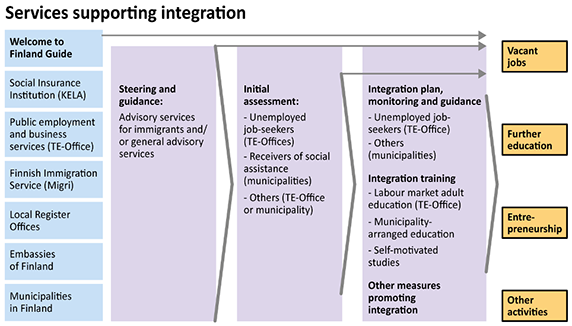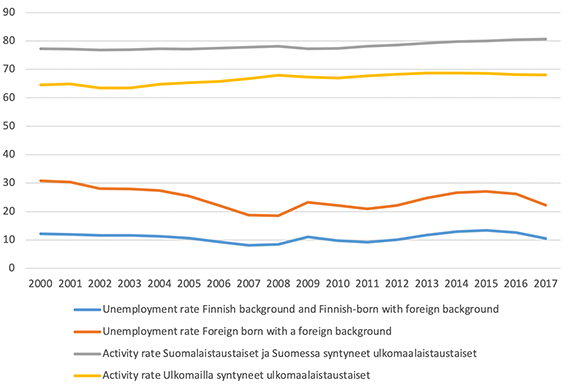[astra_breadcrumb]
Immigration to and Integration in Finland
Pasi Saukkonen
Until the late 1980s, Finland was a country of emigration rather than of immigration. The collapse of the Soviet Union, the development of the European Union, and increasing globalisation ended that situation. Since then, the share of foreign-born people in the population has risen steadily, and the so-called second generation is growing up on large scale. In 2015, Finland received an unforeseen number of asylum-seekers, 32,000 in total, most of them of Iraqi or Afghan origin.
At the end of 2018, there were 387,200 people born abroad in Finland, and they made up 7% of the population. Half of them are living in the Helsinki metropolitan region, with one fourth of them in the capital itself. The biggest contributions to the numbers by country of origin have long come from those born in Russia or in the Soviet Union and those born in Estonia. Those with Somali or Iraqi background later increased significantly in number, especially if the children of immigrants too are taken into account.[1]
Figure 1. Persons born abroad in Finland, 1991–2018 totals (source: Statistics Finland)

[1] Statistics Finland nowadays applies a classification of the population by origin, country of birth, and background country that is similar to those of the other Nordic countries. All such persons as have at least one parent who was born in Finland are considered to be persons with a Finnish background. Persons whose parents were (or only known parent was) born abroad are considered to be persons of foreign background. Both those with a Finnish background and those with a foreign background may have been either born in Finland or born abroad. The background country of those with a foreign background is primarily the country of birth of the biological mother.
Figure 2: The biggest ‘background country’ groups among persons with a foreign background in Finland in 2018 (source: Statistics Finland)

When immigration started to increase, Finland immediately recognised that this would have a lasting impact on Finnish society and that newcomers need support in the first years after arrival. The first Act on Integration of Immigrants and the Reception of Asylum Seekers came into force in 1999. Integration was defined as the personal development of immigrants, aiming at participation in working life and society while preserving their language and culture. Here, integration also meant a two-way process during which Finnish society too changes. Instead of establishing specific service provision for immigrants on a large scale, the idea entailed including them as soon as possible in mainstream services.
The legislation was revised in 2010. Integration services were made available for all those who need them, irrespective of the reason for migration. This need was examined in initial assessments conducted by either a TE Office[2] or a municipality of residence. The next step was, and still is, an individualised integration plan in the preparation of which the immigrant in question is supposed to participate. The integration plan leads him or her to integration education in which teaching of the Finnish (or Swedish) language has a prominent role. The right to an integration plan usually lasts for three years after entry, and the guided integration processes usually take 1–3 years. The most important services supporting immigrants’ integration, their provider, and the groups given focus are visible in Figure 3.
[2] TE Offices are responsible for public employment and business services at the local/regional level.
Figure 3: Services supporting individual immigrants’ integration and the organisations in charge (source: Ministry of the Interior & Ministry of Employment and the Economy 2015, p. 71)

Employment statistics reveal that many immigrants have had problems in finding their place in the Finnish labour market. The activity rate of foreign-born residents is much lower than that of those born in Finland (Figure 4). The difference in belonging to the labour force is especially wide between immigrant women and Finnish-born women. Those who belong to the labour force often struggle with finding a job. The unemployment rate of immigrants has been much higher than that of the native population. Also, the figure below shows that the situation of immigrants in the labour market is more sensitive to economic upturns and downturns. Many of those foreign-born people with a job have a temporary work contract, and they often occupy positions in sectors (such as logistics and construction) that react strongly to macroeconomic development.[3]
[3] The changes also partly reflect differences in immigration patterns related to different economic cycles. Strong economic growth tends to increase labour-based migration; economic downturns in the country of settlement, in turn, diminish the demand for labour and the motivation of work‑seekers to move across the border.
Figure 4: Activity rate and unemployment rate of those with a foreign background and those either with a Finnish background or with a foreign background but born in Finland, 2000–2017 (source: Ministry of Employment and Trade, Statistics Finland)

These findings related to immigrants’ integration are quite common in all countries with an economic system, labour-market structure, and immigrant population similar to Finland’s. Therefore, it is difficult to say whether the more positive and more negatives sides of the situation are caused by Finnish national integration policy. In its recent evaluation of Finnish integration policy, the OECD pointed out three potential sources of shortcomings especially. Firstly, the Finnish system already at the beginning divides immigrants between those belonging to the labour force and those outside it, which might lead the latter to never find their path to Finnish working life. Secondly, the relatively generous system of home-care allowances can be an incentive that encourages women to stay at home with children. Thirdly, the OECD criticised the rigid system of education, in which one is supposed to learn Finnish (or Swedish) properly and only then start focusing on employment possibilities.
There have been some revisions to Finnish integration policy in the last few years. For example, the new modular system of integration education strives for combining language teaching and work opportunities more effectively than was previously the case. Also, there is increasing attention to the individual-to-individual differences among those who integrate. The current government of Finland is supposed to evaluate the need for more profound revision of the integration legislation before the end of 2020.
Sources
Government of Finland. 2019. Programme of Prime Minister Sanna Marin’s Government ‘Inclusive and competent Finland – a socially, economically and ecologically sustainable society.’ Helsinki: Government of Finland.
Ministry of the Interior & Ministry of Economic Affairs and Employment. 2015. ‘Maahanmuuton ja kotouttamisen suunta 2011–2014.’ Ministry of the Interior Publications 2/2015. Helsinki: Ministry of the Interior.
OECD. 2018. Working Together: Skills and Labour Market Integration of Immigrants and Their Children in Finland. Paris: OECD Publishing.
Saukkonen, Pasi. 2017. ‘Interplay and co-operation between national and local levels in integration policy.’ Working Papers 2017:4. Helsinki: City of Helsinki Executive Office, Urban Research and Statistics.
Saukkonen, Pasi. 2020. Suomi omaksi kodiksi. Kotouttamispolitiikka ja sen kehittämisvaihtoehdot. Helsinki: Gaudeamus.
Statistics Finland. 2020. ‘Immigrants and integration.’
https://tilastokeskus.fi/tup/maahanmuutto/index_en.html.
